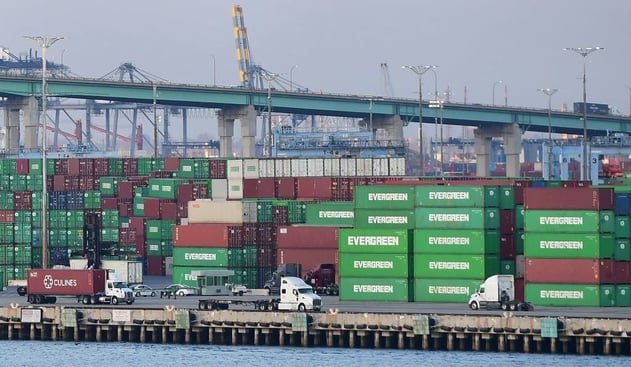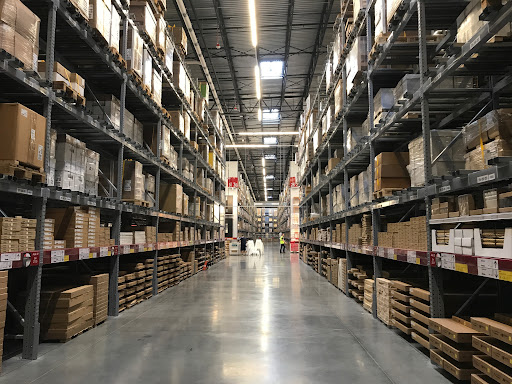Imagine the scene: A family is sitting together in a cozy living room, drinking mugs of cocoa, excitement on their faces as they reach for the beautifully wrapped gifts under the Christmas tree. It’s the picture you see in every magazine, store window and television show in the US this time of year. But now, reimagine the tableau minus the presents under the tree. It just doesn’t have the same effect. Gift-giving is an intrinsic part of the festive season, but this year, the options on offer may turn out to be sparse.
What’s the holdup?
Massive bottlenecks along the supply chain have led to delays of up to five weeks on orders, according to shipping and logistics companies. The setbacks range from Covid-19 challenges at point-of-origin factories and ports, to vessel pile-ups at destination ports in the US, to a shortage of port employees, truckers, and railroad workers.
This means many popular holiday gift items such as electronics, sporting goods, toys, computers, and other goods that move by ocean freight may not make it onto shelves in time. Meanwhile, merchandise produced locally or traveling by air — including jewelry — will feel the impact less.
“What I can tell you is that the situation is still dire for shipping, because since the third quarter of last year, we have seen enormous demand, which leads to congestion in ports and heavy delays in shipping,” says Nils Haupt, senior director of corporate communications for German transportation company Hapag-Lloyd. “Many of the goods that people would normally buy for the holiday season…are stuck at port. It’s not a catastrophe, but if you want to give an electronic bike as a Christmas gift and you just order it at the beginning of November, it probably will not be under the Christmas tree.”
A deficit of stock in warehouses, along with an increased level of sales, has compounded the logistics backup. During the pandemic, there was a drop in orders from retailers, followed by a massive spike in consumer demand as the government distributed stimulus checks. Now, with low inventory and heavy shopping, store owners are struggling to replace those goods before the holidays.
“There’s been concern for a while now about how much capacity is in the network,” says Daniel Hackett, a partner at maritime consultancy Hackett Associates. “And so retailers, worried about potential issues in the supply chain, began moving holiday cargo earlier than normal. Normally, there are peaks and troughs with month-to-month cargo volumes, but now we are just seeing high volume after high volume.”
Pushing through the backlogOn October 13, President Joe Biden challenged the Port of Los Angeles — the largest shipping harbor in the US — to shift to 24/7 operations to help release the blockage in time for products to hit stores before consumers did.
“This is a commitment from industry leaders responsible for moving goods on behalf of American consumers and businesses to open up the capacity needed to deliver,” states Port of Los Angeles executive director Gene Seroka. “It’s a call to action. We have a lot of work ahead. In the [coming] days, we are committed to continuing to be the convener to ensure the supply chain delivers.”
However, while the idea makes sense, the implementation is more difficult, considering the lack of a sufficient workforce to fill those extra hours, says Dave Marcotte of Kantar Consulting.
“Demand can go from nothing to 100, but capacity can’t,” the senior vice president of global research and technology explains. “It takes years to build capacity. There is so much stress throughout the system at the moment, on every single part of the system, and every single transit method. It’s ships, it’s ports, it’s rail, it’s trucks, warehouses. People refer to all these positions as unskilled labor, which is incorrect. These are highly skilled positions in every part of the supply chain, and it takes a while to learn the job. Nobody just walks in and starts moving. So whereas I would have counted 30 days from ordering to delivery, I now have to count about 200 or 250.”

‘Wild, wild west’
Electronics, toys, computers, sporting goods and appliances — items that consistently make it onto Adobe Analytics’ list of most popular gifts — are among the items facing the longest delays.
“Supply and logistics issues are ever present, and they’re destined to get worse as holiday volume kicks in,” says Patrick Brown, vice president of growth marketing and insights at Adobe. “Out-of-stock product messages are up 172% [from pre-pandemic 2020], and 360% compared to 2019. [We] expect it to remain at this level, increasing for certain products throughout the season. Of the 18 categories tracked, apparel has the highest out-of-stock levels currently, followed by sporting goods, baby products, and electronics.”
But how backed up is the supply chain? Will stores be nearly empty, with customers fighting over the last XBox on the shelf? Will we see a rerun of the Cabbage Patch doll riots of the early ’80s?
“It’s complicated to an extreme,” says Marcotte. “My assumption is that most retailers are going to go into the holiday with about 80% of what they want” in terms of merchandise.
However, the situation could be even more dire, according to Matt Kleinschmit, CEO of mobile market research consultancy Reach3 Insights.
“I’ve spoken with a lot of clients, and the theme is very consistent,” he says. “They say they’ve received something like 20% of the stock that they usually do by this time of year, and they’re starting to get very concerned.”
What happens if people can’t find the products they want to give as gifts? Will the US see a Scrooge-like Christmas, with nothing but dust under the trees? Kleinschmit doesn’t think so.
“We’re in this sort of wild, wild west of new shopper,” he observes. “During the pandemic, the population became increasingly adept at navigating disruptions. Nearly half switched brands or products when what they usually bought was unavailable. I can’t help but think that how shoppers react to the upcoming holiday season will be very much influenced by what they’ve experienced over the past two years. So if you use that logic, if they can’t find a particular product they’re looking for, like electronics, I believe they will shift to other products that are in stock.”
Marcotte agrees that people won’t necessarily wait for what they originally wanted to buy, given the “intense” need to present loved ones with gifts this year after missing out on last holiday season.
“Shoppers have shown a lot of flexibility in terms of what they’re buying,” he says. “And they’re sitting on savings, so they’re considerably less price-sensitive than they were before. That opens the door for luxury gifts in a way that’s pretty unique.”
A deal by comparison
Jewelry can fill the gap left by other categories of consumer goods, believes Tim Vierengel, senior equity research analyst with Northcoast Research.
“Demand [from jewelry consumers] remains remarkably strong, with...universal sentiment among the jewelers themselves that consumers are not [reverting to their pre-pandemic] spending habits as quickly as anticipated,” he says. “That means they’re not shifting their spending back away from jewelry.”
High prices on other inventory that makes it onto store shelves will also steer shoppers toward jewelry purchases. Between companies passing the higher shipping costs on to customers, and the fact that traditional Black Friday sales are unlikely to play out due to the product shortages, electronics and other goods may not be such a good deal.
“Every retailer I speak to is uncertain about what product they will have in place to be sold,” says Marcotte. “Nothing is going to be on sale. Those big sales that you normally see, with price reductions and whatnot, that’s really not going to happen, because they don’t need it. They don’t need to reduce the price of things to sell anything.”
And that, Vierengel explains, is what will make the difference. “Jewelry and apparel...almost look like a deal relative to the big price increases everywhere else,” he says. “I would say things are going to be good [for jewelry]. Things are probably going to be better than many expect.”
The domestic advantage
Maybe the most important factor is whether jewelers will have the inventory to meet that demand when it comes. One advantage they have over toys, computers and electronics is that those categories are primarily sourced from China and other overseas markets, while a large proportion of jewelry comes from US-based manufacturers such as Stuller.
“Our supply chain has been challenged this year,” says Stuller president Danny Clark. “However, we have worked diligently to resolve all issues and are in a strong position to support holiday sales. We anticipate being able to meet all demand from our customers this holiday season.”
In addition, smaller, high-value items such as jewelry usually travel by air freight rather than sea. This means that a large portion of the logjam and waiting periods won’t apply.
“I have everything that I need for Christmas right now; I am not waiting for anything,” says Susan Purnell, owner of Kuhn’s Jewelers in Salisbury, Maryland. It’s a good thing, too; Purnell’s customers have already begun shopping for the holiday season. “Last Christmas was wonderful, but this year, already in September, we had huge sales, and we were way, way ahead of last year. Now we’re sitting about 30% above last year.”
In particular, Kuhn’s has been gift-wrapping a whopping number of engagement rings for the people planning to get down on one knee during the most popular proposal time of the year.
However, Mark Clodius, owner of Clodius & Co. Jewelers in Rockford, Illinois, has encountered some stock constraints from one of his biggest suppliers, an Indian company that manufactures in China. While that hasn’t prevented him from filling his shelves with previously ordered and US-sourced items, he fears demand might be so good that he won’t be able to restock hot sellers.
Like Purnell, he has also been selling high volume, most notably those shiny symbols of love. “People [have particularly been coming in] for engagement rings,” he says. “They’re planning early, looking to have those Christmas proposals, and working with us to find the right diamond to fit their price and style.”
As for the last-minute shoppers, Clodius is counting on them. “We’re planning on doing our marketing this year to speak to those procrastinators. It’s aimed at anyone who would normally shop in other stores. And we’ll say, ‘We don’t know if you’re going to be able to buy what you want [for the holidays] this year, but whatever she wants, we have it, and it’s in stock.’”